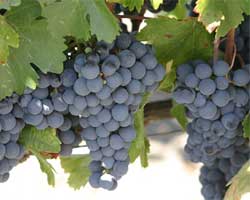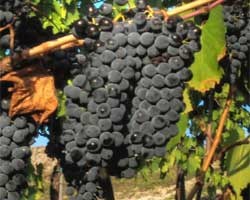Winemaking has become big business in America, especially in California and Washington–the two largest wine producing states in the nation. There are more choices than ever when it comes to purchasing wine. It used to be that the shelves were just stocked with European wines, before the Napa Valley revolution hit in the latter part of the last century. Most American vintners focused on particular grape varietals, like Chardonnay, Cabernet Sauvignon, and Merlot, to name a few. But, as of late, new grape varietals (many of which have fabled histories in other countries) have become all the rage in the U.S. Here’s a look at several grapes that are helping to change the American winemaking scene. (It’s important to note that some people don’t believe that wines made with grapes grown outside these respective countries can truly be remarkable.)
1) Viognier
 |
Viognier (pronounced vee-ohn-yay) has been popular in recent times. Many grape growers and winemakers are starting to see the glory of this Rhone Valley white grape, which nearly vanished a few years back in France–it is reported that there were only 50 or so acres left in that country. Thanks to several American wineries, this grape has made a comeback. Viognier is known for its bright, citrus notes (think grapefruit) and somewhat dry finish. And it’s often used (in small amounts) in the making of Syrah, a red wine that has recently been extremely popular in America. This fruit-forward wine has had great success in northern California, Washington’s Columbia Valley, and Idaho’s Snake River Valley.
2) Malbec
 |
Even though this red varietal hails from Bordeaux, it has flourished in Argentina–essentially becoming the national wine of this rugged South American country. Malbec is a medium-bodied red wine (it smacks of ripe Merlot) that boasts a dark hue and plum-like flavors, making it a good pick for pasta with red sauces and grilled sausages. Finding domestic Malbecs a few years ago was virtually impossible, though, until a handful of American vintners started growing this early-ripening grape in California, Washington (especially Walla Walla), and Idaho. Australian winemakers also have had great results with Malbec in the last decade.
3) Barbera
 |
Barbera is another red varietal that American vintners are starting to plant with great success. This Mediterranean grape (it has ancient roots in northern Italy) likes long, hot days and cool nights, making it a good fit in the vineyards of California and Washington, where this kind of climate is the norm. Barbera is extremely drinkable, with its pronounced fruit flavors (think blackberries and currants) and low tannin level. This versatile yet sturdy wine plays well with a large variety of dishes, like cioppino and sausage ragout. Don’t be surprised to see American-made Barberas all over menus in the coming years
4) Sangiovese
 |
Sangiovese (pronounced san-jo-vay-zay) is another Italian red grape that grows well in America. It was first brought to California in the late 19th century by Italian immigrants, who used it for making red blended wines, like Chianti, as was the case in Tuscany. This grape thrives in hot, dry climates, making it a good pick for vintners in Washington’s Columbia Valley. (The grape tends to rot in wetter climates.) Wines made with Sangiovese are often fruit-forward with high acidity. Medium-bodied wines with slight floral notes are the common end result with this varietal. American winemakers like the concentrated flavors of this grape, which happens because it ripens later than other red grapes. So, expect to see lots of domestically produced Sangiovese (not just blends) in the years to come.
5) Gruner Veltliner
Isn’t Gruner Veltliner fun to say? This Austrian white grape (it’s actually the national varietal of that country) has been cultivated in Europe since Roman times. Wines made with this grape taste wonderful at a young age. Expect lots of bright, clean flavors with a mineral-like finish. Many of these white wines boast pronounced tropical fruit flavors, followed by vegetable undertones, like an essence of green beans and asparagus. Gruner Veltliner pairs well with wild mushrooms and shellfish. Like Gewurztraminer, this grape thrives in the mountainous foothills of southern Europe. It also grows well in cooler maritime climates, like Oregon’s Willamette Valley, where a few good Gruner Veltliners are currently being made. Don’t be surprised to see more of these white wines in the future.
We always want to be transparent and honest about our article content. From time to time, we may link to products and services that compensate us for the referral. This does not affect your cost, but it does help us fund future content for this site.
